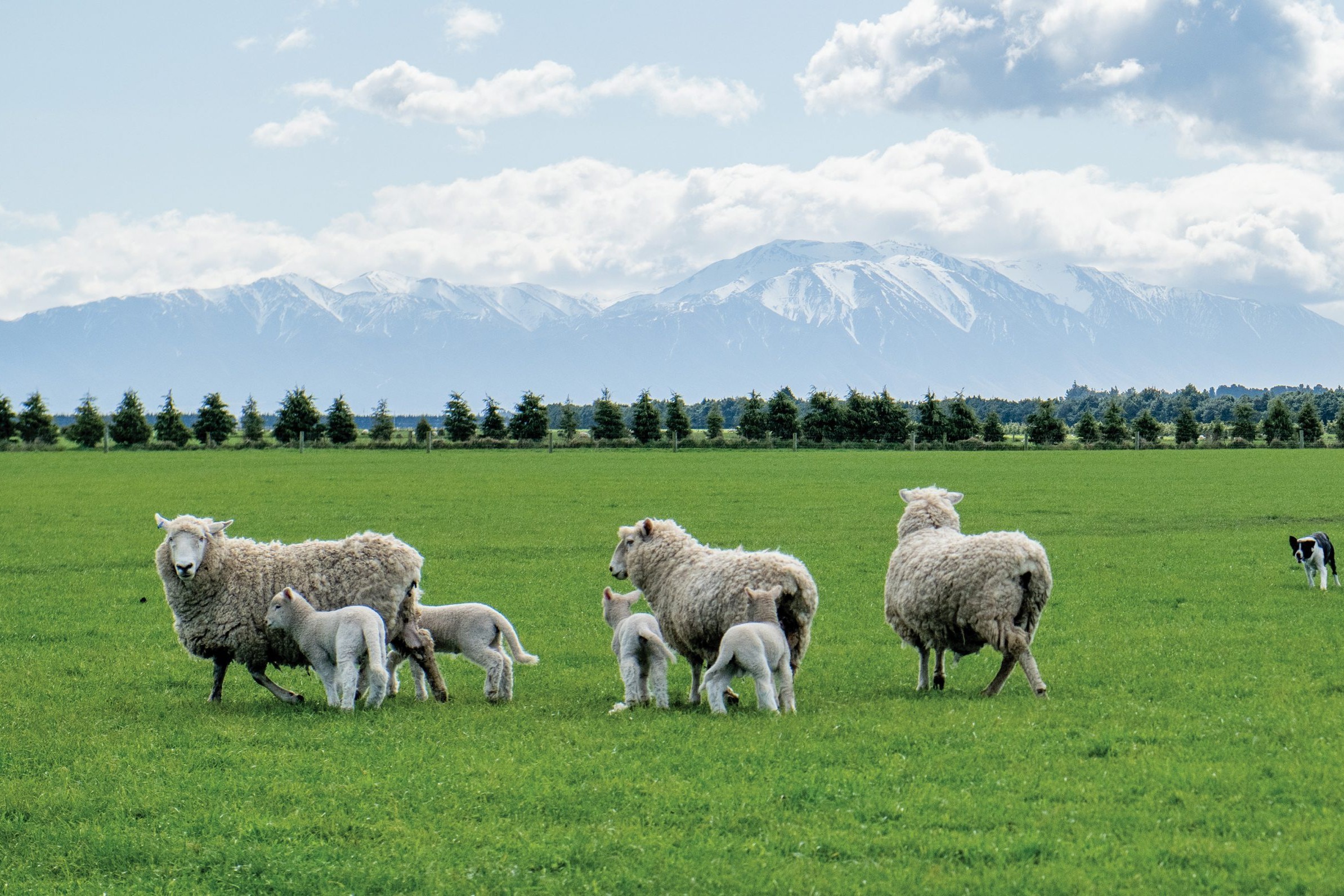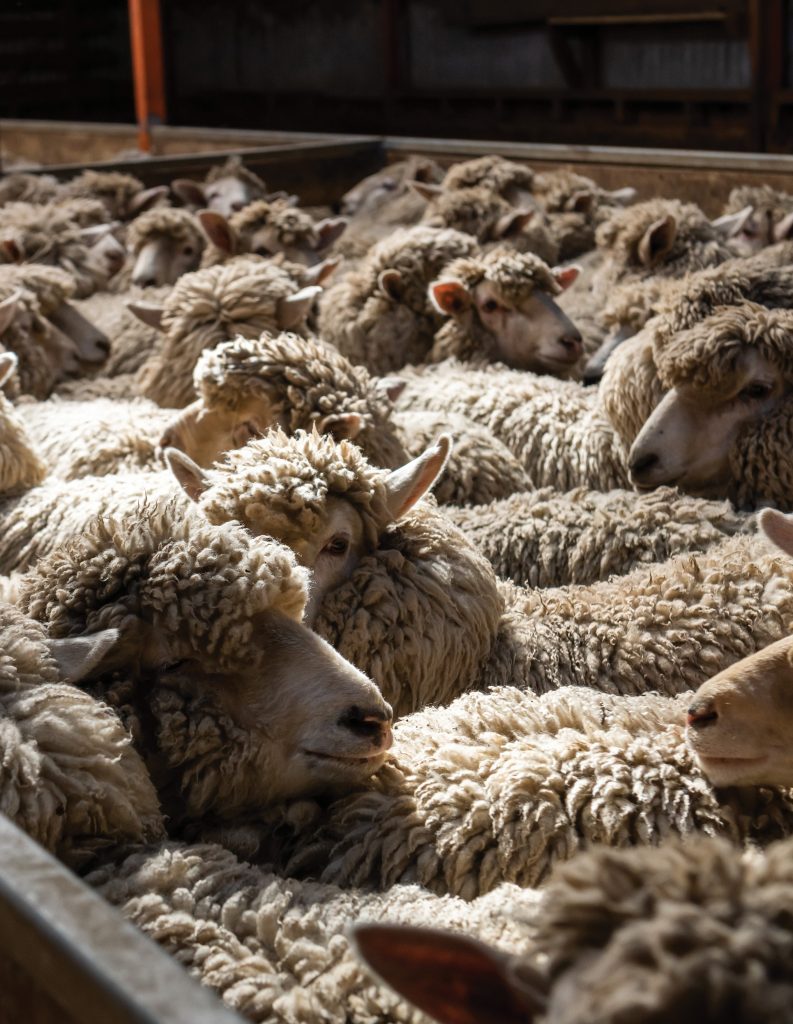Chertsey’s fast finishers
A combination of new technologies and good stockmanship sees the lambs from the Copland family’s Canterbury operation early to the works. Story by Sandra Taylor.

A combination of new technologies and good stockmanship sees the lambs from the Copland family’s Canterbury operation early to the works. Story by Sandra Taylor.
GENETICS, GOOD QUALITY PASTURE and old-fashioned stockmanship underpin the Copland family’s fast-finishing lamb system.
In just 12 weeks, the family that farms Westmere near Chertsey in Central Canterbury are weaning lambs that kill out at 18–19kg carcaseweight (CW), and typically have all of their lamb crop gone by the end of February. This allows room for trading lambs that are finished for winter contracts.
Mark Copland and his wife Robyn look after the sheep side of the family’s business that also includes cattle finishing and a range of arable crops. These include seed and process peas, grass-seed, cereals and process potatoes. The couple’s son Hugh looks after the cattle and crops and also runs a sheep milking operation, along with his wife Kylie, on a separate block.
Mark is the third generation of the Copland family to farm the 670-hectare property where new technologies sit comfortably alongside tried-and-true stockmanship and animal husbandry.

Until 10 years ago, Mark (64) was still using a horse and cart to do the lambing beat. While the horse has since been retired, the cart has been modified so it can be towed behind the farm’s side-by-side at lambing.
In 2003 the family began an irrigation development programme that now covers 500ha. Drawing water from four bores that feed four centre-pivots and a lateral irrigator, this development proved a game-changer, giving the family the certainty to grow a range of cash and forage crops.
Mark says the arable crops are probably the most profitable part of the business on a per-hectare basis, but there is integration between the two enterprises. While the crops benefit the livestock, the opposite is also true, with the pasture breaks and fertility provided by the livestock benefiting after the sheep side of the family’s business that also includes cattle finishing and a range of arable crops. These include seed and process peas, grass-seed, cereals and process potatoes. The couple’s son Hugh looks after the cattle and crops and also runs a sheep milking operation, along with his wife Kylie, on a separate block.
Mark is the third generation of the Copland family to farm the 670-hectare property where new technologies sit comfortably alongside tried-and-true stockmanship and animal husbandry.
Until 10 years ago, Mark (64) was still using a horse and cart to do the lambing beat. While the horse has since been retired, the cart has been modified so it can be towed behind the farm’s side-by-side at lambing.
In 2003 the family began an irrigation development programme that now covers 500ha. Drawing water from four bores that feed four centre-pivots and a lateral irrigator, this development proved a game-changer, giving the family the certainty to grow a range of cash and forage crops.
Mark says the arable crops are probably the most profitable part of the business on a per-hectare basis, but there is integration between the two enterprises. While the crops benefit the livestock, the opposite is also true, with the pasture breaks and fertility provided by the livestock benefiting the arable side of their business.
“We’ve gone from a dryland sheep operation to having a finger in many different pies,” Mark says.
Ewe numbers on Westmere have gradually decreased over the years (once peaking at more than 6000), making way for the arable crops and cattle trading. Today Mark and Robyn run 1300 commercial Border Romney ewes alongside 200 Border Leicester stud ewes.
The McCombie Border Leicester stud was started by Mark’s grandfather in 1932 and registered in 1933. Similarly, the farm has run commercial Border Romneys since Mark’s grandfather’s day, but Mark describes the breed as a good stable sheep that perform well in the middle of the Canterbury plains whether it is wet or dry.
He says the irrigation has enabled them to feed stock well throughout the year on a mix of pasture and winter forage crops such as Kestrel kale and swedes. These crops are grown for replacement ewe lambs and winter trade lambs, while fodder beet is grown for trading cattle.
Before going to the ram, the ewes are rotated around cereal stubble and post-harvest potato paddocks and this, combined with their inherent fertility, means the ewes are reliably scanning 190–200%.
Most of the ewes are put to a Poll Dorset ram, a breed Mark credits for giving them the high pre-weaning growth rates that allow them to get 40% of their lambs away prime at the weaning draft in mid-November.
“They’re good lambs. They’re really placid lambs and they really thrive.”
The Poll Dorsets have been a mainstay of their prime lamb operation since Mark and Robyn’s late son Todd (who sadly died of cancer) eyed up the breed at the Christchurch show.
He encouraged his father to go to Neville and Diane Greenwood’s ram sale where they bought a small number of rams. Within days, Todd had single-handedly decided their black-face terminal rams no longer had a role in their sheep breeding programme and had turned them into dog tucker.
Mark had to quickly top up his ram numbers with more Poll Dorsets for the upcoming breeding season and he hasn’t looked back.
“They’re a placid, gentle-giant type of sheep,” he says.
When selecting terminal sire rams, he always looks at their balance, depth of loin and hindquarters before looking at the numbers for early maturity and weight gain. He also focuses on weaning weight and 200-day weights.
He particularly likes the breed’s carcase depth and says they have a good engine, which gives them the meaty carcases they are looking for in their prime lambs.
The commercial ewes are strip-grazed on grass over winter and will only receive supplement if it’s particularly wet and cold.
Going into lambing, Mark and Robyn divide their paddocks up with hotwires (although they’re not turned on) and the ewes lamb within these cells. Mark sheds the yet-to-lamb ewes off every day and gradually builds up bigger mobs of ewes and lambs. They stay in these mobs until tailing.
Last year the ewes tailed 162% which reflects previous years’ percentages.
Lamb rearing system
One of the downsides of having highly fertile ewes is the number of triplets. The triplet-bearing ewes are separated out before lambing, but Mark and Robyn still end up with a number of orphan lambs.
To deal with these, the couple have set up a lamb rearing system in a north-facing purpose-built shed. Using a De Laval automatic lamb feeder, last year Robyn reared 110 lambs and looks to do a similar number this year. Three years ago, she reared nearly 200 lambs.
The lambs are taught to bottle feed manually before they progress to the pens where they have ad-lib access to milk, emulating what they would do in the paddock.
Mark says studies have shown that a lamb will feed off a ewe up to 40 times a day, Mark says, hence the Copland’s desire to give the lambs ad-lib access to the milk. They also have access to meal and straw.
They use Sprayfo milk powder as this doesn’t cause the bloating or gastric issues associated with traditional lamb milk powders.
While the hand-reared lambs won’t ever make the weaning drafts, both Mark and Robyn say they catch up with their peers quickly and are indistinguishable in subsequent drafts, apart from being over-friendly in the yards.
After the weaning in mid-November, the remaining lambs are rotated around pasture and another draft is taken before Christmas.
Remaining lambs are shorn, which Mark says prevents flystrike and helps drive growth rates.
“It’s an expensive way to do it, but we’re getting a good animal out the gate.”
All lambs are sold to AFFCO.
Another trick the Coplands use is to give their lambs a dose of Lambex along with selenium at tailing and in any subsequent drenches. It’s a nutritional feed supplement, containing trace elements, that purports to aid rumen performance. Mark and Robyn say the product seems to make the lambs a lot more settled, particularly after weaning.
Ewe lambs are not mated. Mark says they would rather focus on the mixed-age ewes and believes by not mating them as hoggets, they get another year out of them in the mixed-age flock.
September grass growth
Mark says grass growth on Westmere doesn’t really kick into gear until late September, but good fertility, thanks to generations of livestock farming combined with their fertiliser programme, means they are getting excellent grass growth in October and November.
Their crop rotations mean they are turning paddocks over every five or six years and Mark uses a perennial ryegrass combined with red and white clover that’s performing very well in their environment.
This year the Coplands wintered 2700 Halfbred lambs on winter forage crops and these will be shorn in spring and the lambs sold prime.
They have been buying in Halfbred lambs for several years now and while they were particularly profitable a couple of years ago, an easing in mid-micron wool prices has cut returns.
The family does all the tractor work themselves and alongside Mark, Robyn and Hugh, they employ one full-time staff member and bring in casual labour when required. Two people are employed at lambing in the sheep milking unit and they will lend a hand on Westmere when needed.
Mark believes that commercial ewe numbers on Westmere will continue to decline and while he jokes that they are just a hobby flock now, they are high-performing ewes that produce good quality fast-finishing lambs.
While he hopes the Border Leicester stud will make it to its 100-year anniversary, the way stud rams are sold is changing rapidly and last year they sold their genetics online.
The breed is sought after for cross-breeding programmes.
Mark enjoys showing his sheep and is a well-known dog trialer whose dogs earn their keep on the farm as well as on the trial course.




